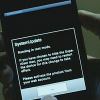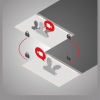Viruses may soon be on a handheld near you
Though there have only been 12 viruses that specifically target handheld devices like mobile phones and PDAs, the next year or two is likely to see an explosion of viruses for these platforms, said Bob Hansmann, enterprise product manager for anti-virus firm Trend Micro Inc. Speaking during a presentation at The Internet Security Conference Thursday, Hansmann said viruses did an estimated $1.5 trillion of damage in 2000.
Virus writers always attack the systems that are popular and accessible, Hansmann said, noting that the explosion in mobile devices with wireless access such as cell phones and Palm OS or Pocket PC PDAs (personal digital assistants) will in turn bring new viruses.
People are going to write viruses for the devices they have access to" and information about, he said, and "as these systems increase in popularity, that's what they're going to write viruses for."
The ubiquity of these devices and viruses written for them is troubling because of the virus creation kits that help make the virus writing a process a matter of a few mouse clicks, he said.
"Anyone, anywhere can create a virus. You don't have to know anything, (but) just have access to a browser and the Web."
Though few such viruses, and none written using virus creation kits, have yet emerged, a few notable wireless viruses give a glimpse of what may be in store.
One virus, called "Staple," which is an anagram for the first six letters of Palestinian, sent a pro-Palestinian protest letter, signed with the name of the owner of the device, to 25 members of the Israeli parliament, he said. Another, called 911, flooded Tokyo's emergency response phone system using an SMS (short message system) from a PC that was sent to over 100,000 mobile phones. The message told its recipients to visit a Web page and when they did, a script executed that caused the phones to call 110 -- Tokyo's equivalent of the U.S.'s 911, Hansmann said.
The example of 911 underscores that services like I-mode, NTT DoCoMo Inc.'s hit multimedia wireless service, are currently larger virus threats than Palm OS or Pocket PC, he said. This is because I-mode has more functionality than the other two, he said, but cautioned that "as device's capabilities grow, the threat will grow."
And those threats are likely to grow across a broad swath of technologies, including XML (extensible markup language), Java and the Bluetooth wireless networking protocol, he said. All three technologies are, or soon will be, incorporated into many mobile devices. Mobile viruses may also make their way onto standard networks as mobile devices are synched with their desktop counterparts, he said.
The news is not all doom and gloom, however, as steps are being taken to fight the spread of wireless viruses. Telecommunication providers, including the biggest carriers and names in the industry, are already discussing adding anti-virus software to their wireless gateways and other parts of their infrastructure, Hansmann said. E-mails are already scanned for viruses on many of these networks and as more applications are brought forth, so will different types of scanning.
The devices themselves will also likely have anti-virus software, he said. Both Trend Micro and Symantec Corp. already offer such software.







































































